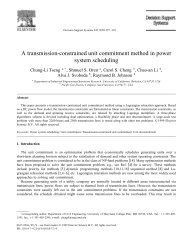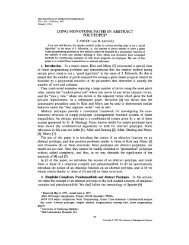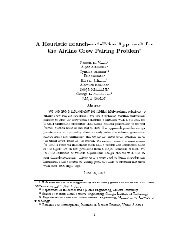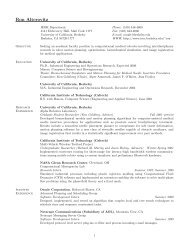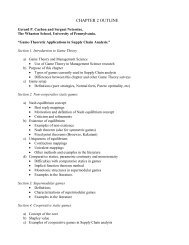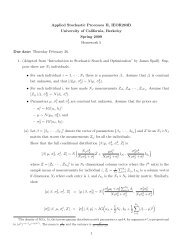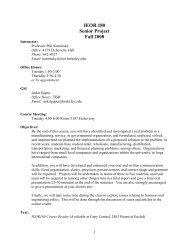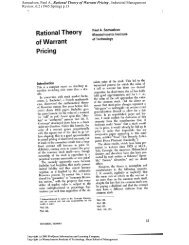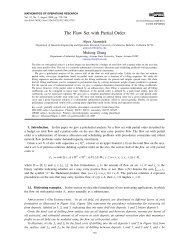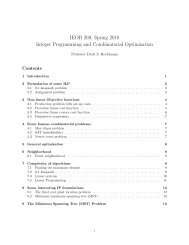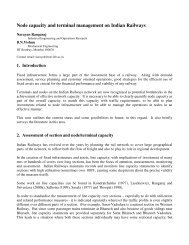IEOR 130 Methods of Manufacturing Improvement Fall, 2013 Prof ...
IEOR 130 Methods of Manufacturing Improvement Fall, 2013 Prof ...
IEOR 130 Methods of Manufacturing Improvement Fall, 2013 Prof ...
You also want an ePaper? Increase the reach of your titles
YUMPU automatically turns print PDFs into web optimized ePapers that Google loves.
After a single exposure is completed, the X-Y stage moves the wafer over for the<br />
exposure <strong>of</strong> the next field. The fixed time for the mechanical apparatus to move the wafer<br />
and re-align the camera is called the move time (MT). There is no MT before exposing<br />
the first die; all initial motion <strong>of</strong> the wafer on the X-Y stage is included in AT.<br />
For the die types produced in this factory, there are no "test keys" printed on the wafers.<br />
The entire wafer surface is printed with product dice.<br />
After exposures <strong>of</strong> all wafers in the cassette are completed, the cassette can be removed<br />
from the machine and the exposed wafers are then sent through a development process.<br />
(Similar to the way the machine can hold two cassettes <strong>of</strong> inbound wafers, there is room<br />
in the machine for two outbound cassettes. A full outbound cassette can be removed from<br />
the machine while it continues to process wafers into the other cassette.) After<br />
developing, the wafers are inspected under a microscope. If for some reason the exposure<br />
was mis-aligned with earlier mask layers, the current layer can be stripped <strong>of</strong>f in an acid<br />
bath, and the wafers sent back through the stepper for a second try. This repetition is<br />
known as rework. Let RW denote the fraction <strong>of</strong> total wafer operations performed on the<br />
5X stepper that are rework.<br />
The operational procedures followed in the factory sometimes result in the machine being<br />
completely flushed out <strong>of</strong> wafers and falling idle. For quality control purposes, the<br />
machine might be deliberately stopped after processing one wafer and held idle while<br />
waiting for the results <strong>of</strong> the after-develop inspection. When the machine is to be used<br />
again after becoming idle, the machine is inactive while the operator puts in a new reticle,<br />
puts in a new cassette, enters the appropriate recipe, and starts the machine. It then takes<br />
the machine some time to bring the first wafer from the inbound cassette to the X-Y stage<br />
in order to start the basic processing cycle described above. The sum <strong>of</strong> all these delay<br />
times is called a setup time (ST). Let WPS denote the average number <strong>of</strong> wafers<br />
processed between setups.<br />
The industrial engineer for the fab has collected the following data about a particular 5X<br />
stepper in the factory:<br />
Parameter Theoretical Average<br />
LI 770 mW/sq cm 720 mW/sq cm<br />
MT 0.46 sec 0.47 sec<br />
AT 27.0 sec 29.0 sec<br />
XT 12.0 sec 12.0 sec<br />
ST<br />
150 sec<br />
(a) Provide a formula for the theoretical processing time (seconds per wafer) as a function<br />
<strong>of</strong> the number <strong>of</strong> exposures per wafer (NE), the exposure energy (EE), and the numerical<br />
parameters above.<br />
4




